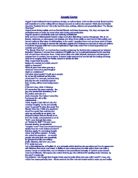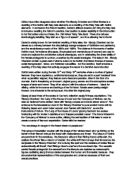"The Bloody Chamber" by Angela Carter - With close reference to one of the tales, discuss how Carter draws upon and subverts conventions of the fairy tale
“The Bloody Chamber” by Angela Carter
“With close reference to one of the tales, discuss how Carter draws upon and subverts conventions of the fairy tale”
Usually fairy tales are told to children to teach them a moral lesson in life or as is mostly the case, help them tell the difference between good and bad. Angela Carter is someone known to take elements from fairy tales and turn them into well written, exciting, compelling complex dramas of a Gothic nature filled with sexual innuendo, a combination of different narrations (mainly first and third), strong heroic female characters and the evil villain – the male. “The Bloody Chamber” is a modern interpretation of the “Blue Beard” (character below) fairy tale which uses this very formula to create an exciting and dramatic story.
In a nutshell both stories are about young women (in their late teens, on the verge of turning into womanhood) who marry a wealthy man and leave a life of modesty behind them. The young women are given a set of keys which allows them to explore every room in the house – except one (the ‘bloody’ chamber) , if that room is entered, dire consequences shall follow (death). Naturally the young women ignore the advice of their intimidating, menacing and much older husbands to enter the room and fall into the trap set up for them and like every disobedient child, they MUST be punished.
With reading the “Bloody Chamber” one can quite quickly understand that it isn’t a fairy tale at all because of the narrative perspective used and they way the story pans out.

This is a preview of the whole essay
Peer Reviews
Here's what a star student thought of this essay
Quality of writing
Spelling and grammar are both excellent. However, expectations for academic essays involve a degree of formality; sometimes the writer uses colloquialisms and idioms which make the essay seem more informal and less credible as a formal consideration of the question. Phrases such as “in a nutshell” and the use of “pretty” as a synonym for “quite” could be replaced by “essentially”, or an evaluative “to a large extent”, respectively.
Level of analysis
There is a good consideration of themes, imagery and other stylistic devices, which are generally supported by quotes. This could be extended by analysis of individual words. For instance, the writer uses the quote “perhaps, here, in his subterranean privacy, I might find a little of his soul..." to suggest the heroine's insatiable curiosity and thus inherently different from traditional fairy tales. However, this quote could be interpreted in different ways: the words “subterranean privacy” hint at the liminality of the Marquis' personality, as the heroine has to physically delve into new territories (“subterranean” literally meaning 'under the ground') to find out what lies beneath his superficial exterior. From this alternative analysis, evaluation is more natural: which of these interpretations are most likely? Do these words reflect more on the character of the Marquis or the heroine? Different viewpoints are considered more generally, such as religious and feminist perspectives. This is good as it signals a consideration of ambiguities and more than one view. This is shown excellently in the conclusion, where the writer explicitly compares how different readers would interpret the tales, and how this links to the initial question of the essay. The last line of the essay is particularly strong, as it directly compares fairy tales and Carter, linking back to the essay question. This gives the essay a sense of completion and generally satisfies the reader that the writer has come to an overall conclusion without merely making a summary of points made.
Response to question
The writer does extremely well in first considering what the conventions of traditional fairy tales are, and then comparing these to 'The Bloody Chamber'. Each paragraph analysing Carter's tales always links back to the focus point of the Bluebeard story. These explicit references show an examiner that the writer is continually aware of what the question is asking. Paragraphs are structured well with topic sentences, which clearly signpost to a reader what each section is about.







